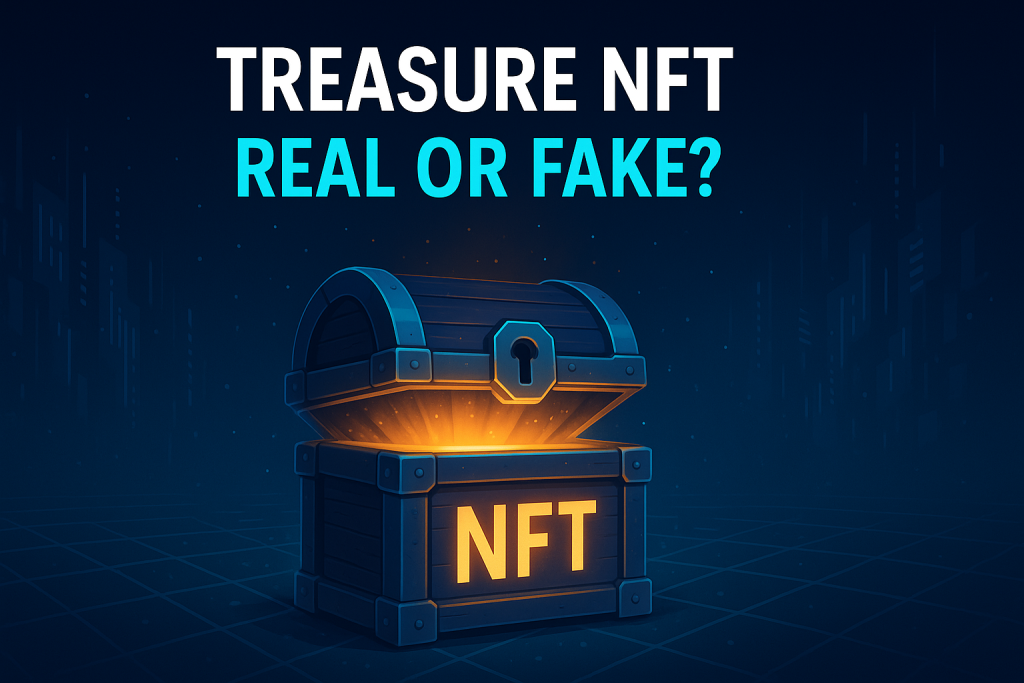Treasure NFT – Real or Fake? Everything You Need to Know
Treasure NFT – Real or Fake. In the ever-evolving world of digital assets, NFTs (Non-Fungible Tokens) have taken the internet by storm. From digital art to virtual real estate, the NFT space has created millionaires overnight — but also opened doors for scams and shady projects. One name you might have stumbled upon recently is Treasure NFT. But this raises the big question — Treasure NFT: real or fake?
This detailed blog post dives deep into what Treasure NFTs are, their origins, red flags, and how to determine if they’re a legitimate project or just another internet scam. We also cover essential tips on how to protect yourself when navigating the NFT space.
What Is a Treasure NFT?
Treasure NFT typically refers to a digital asset listed under the “Treasure” ecosystem or projects using the word “Treasure” in their branding. In many cases, these NFTs claim to offer rare digital collectibles, sometimes tied to a virtual game, a metaverse, or even hidden “treasure hunts” promising large returns.
However, the NFT market is decentralized, meaning there is no central authority regulating what can or can’t be published on marketplaces like OpenSea, Magic Eden, or TreasureDAO. This opens the floodgates for both creative and fraudulent listings.
Real Projects vs. Scams: How to Tell the Difference
Before labeling Treasure NFT as real or fake, it’s essential to differentiate between legitimate projects and scam tokens.
1. Check the Project’s Background
Is there a whitepaper, roadmap, or a founding team behind the project? Real NFT projects usually provide a clear outline of their mission, goals, and technology.
2. Social Proof and Community Engagement
Look for active communities on Twitter, Discord, or Telegram. If engagement looks fake or inflated, it’s a red flag.
3. Smart Contract Transparency
Real NFTs have verified smart contracts viewable on blockchain explorers like Etherscan.
4. Platform of Listing
Scams are usually not listed on trusted marketplaces like OpenSea. Always verify the creator profile.
The Rise of TreasureDAO: A Legit Project?
There’s an important distinction: TreasureDAO, built on the Arbitrum blockchain, is a legitimate NFT ecosystem. It connects metaverses through a shared decentralized economy using a native token called $MAGIC.
If you are referring to TreasureDAO NFTs, then these are real, community-supported assets. However, be cautious — many fraudulent projects mimic TreasureDAO’s name to confuse buyers.
Common Treasure NFT Scams to Watch Out For
Fake Giveaways: “You won a Treasure NFT. ” scams usually lead to wallet-draining smart contracts.
Rug Pulls: Projects that disappear after collecting money from investors.
Impersonation: Fake projects that mimic legitimate NFT brands and visuals.
Fake Listings: Listings that trick buyers into purchasing fake versions of real NFTs.

Real or Fake? A Checklist for Treasure NFT
Use this quick checklist to verify if a Treasure NFT project is legit:
| Criteria | Real Project | Scam Alert |
|---|---|---|
| Verified team | ✅ Yes | ❌ No info |
| Professional website | ✅ Yes | ❌ Basic or none |
| Roadmap or whitepaper | ✅ Yes | ❌ None |
| Active social media | ✅ Yes | ❌ Inactive or bots |
| Transparent smart contracts | ✅ Verified | ❌ Hidden or fake |
| Listings on reputable platforms | ✅ OpenSea, Magic Eden | ❌ Suspicious DMs or sites |
| Token utility | ✅ Use case | ❌ No real purpose |
| Audits or reviews | ✅ Sometimes | ❌ Never |
| Founder accessibility | ✅ Public profiles | ❌ Anonymous |
What to Do If You Already Bought a Fake Treasure NFT
Unfortunately, blockchain transactions are irreversible. But here’s what you can do:
- Revoke access: Use Revoke.cash to remove permissions from malicious contracts.
- Report: Notify the platform (like OpenSea), and report the project.
- Warn others: Share your experience on forums and social media.
- Improve security: Use trusted wallets or hardware wallets like Ledger or Trezor.
Tips to Avoid NFT Scams in the Future
- Never click on suspicious links or DMs.
- Verify the project’s smart contract address.
- Double-check community channels and team info.
- Use analytics platforms like CoinGecko, DappRadar, and Etherscan.
Final Verdict: Is Treasure NFT Real or Fake?
The answer depends on which Treasure NFT you’re referring to. TreasureDAO and its related assets are real. But beware — many fake Treasure NFTs are exploiting the name for scams.
Always do your research before investing. Use our checklist, follow the safety tips, and never act out of FOMO.
Conclusion
The NFT world offers incredible potential but comes with significant risks. Whether Treasure NFT is real or fake depends entirely on the project’s transparency, community, and use case. Stay smart, stay safe, and don’t fall for hype.
Have you encountered a suspicious Treasure NFT? Drop a comment below and share your experience to help others!
Tags: #TreasureNFT #IsTreasureNFTReal #NFTScams #CryptoSecurity #NFTTips

